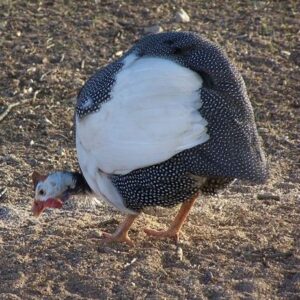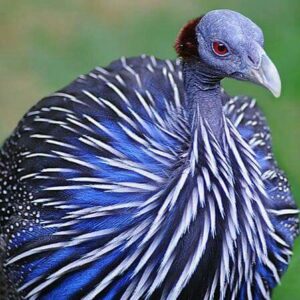The Lavender Guinea Fowl is a stunning and distinctive variety of guinea fowl, admired for its soft, pale bluish-gray plumage covered in white spots. This striking coloration, often described as “lavender,” gives the bird an elegant and unique appearance that makes it a favorite among poultry enthusiasts and ornamental bird keepers. Known for their hardiness, adaptability, and practical benefits, Lavender Guinea Fowl are an excellent addition to farms, gardens, or backyards.
Physical Characteristics
Lavender Guinea Fowl have a medium-sized, rounded body covered in pale bluish-gray feathers that shimmer in sunlight. These feathers are patterned with small white spots, creating a visually appealing contrast. Like other guinea fowl, they have a bare head with blue and red patches of skin and a small bony casque on top. Their legs are strong and adapted for ground foraging, while their short, curved beak is perfect for picking up seeds and insects.
Behavior and Social Traits
Lavender Guinea Fowl are active and social birds that thrive in flocks. They are highly vocal, using a variety of calls to communicate and alert others to potential threats. Their loud, distinctive calls make them excellent “watchdogs” for farms or properties. They are primarily ground-dwelling birds, spending most of their time foraging for food such as insects, seeds, and grains. Despite their preference for the ground, they can fly short distances and often roost in trees or coops at night for safety.
Habitat and Care
These birds are hardy and adaptable, thriving in a range of environments, including open grasslands, farmlands, and backyards. They are well-suited to free-range systems, where they can forage naturally, but they also adapt to confinement if provided with sufficient space and enrichment. Lavender Guinea Fowl require minimal care, needing access to clean water, shelter, and protection from predators. Their hardiness makes them suitable for both beginners and experienced poultry keepers.
Reproduction and Breeding
During the breeding season, Lavender Guinea Fowl form pairs or small groups for mating. Females lay clutches of 12–15 small, hard-shelled eggs in hidden ground nests. These eggs incubate for about 26–28 days before hatching. The chicks, known as keets, are precocial and can move and forage shortly after hatching but need warmth and protection during their early weeks. Their soft, downy feathers often carry a hint of lavender, making them as charming as the adults.
Benefits and Uses
Lavender Guinea Fowl are valued for both their ornamental appeal and practical contributions. Their unique plumage makes them a standout addition to any property, while their active foraging behavior helps control pests such as ticks, grasshoppers, and other small insects. They also produce lean, flavorful meat and nutritious eggs, though they are more commonly kept for pest control and ornamental purposes than for production.
Popularity and Conservation
Lavender Guinea Fowl are not a wild species but a domesticated variety bred for their beautiful coloration and utility. Their popularity continues to grow due to their low maintenance requirements and dual-purpose value. They are widely available and sought after by hobbyists, small-scale farmers, and ornamental bird collectors.
Conclusion
The Lavender Guinea Fowl is a captivating and practical bird, combining elegance with utility. Its pale bluish-gray plumage and active, social nature make it a joy to keep, while its ability to control pests and thrive in various environments adds to its appeal. Whether kept as an ornamental bird, a natural pest controller, or both, the Lavender Guinea Fowl is a valuable and rewarding addition to any flock.







Reviews
There are no reviews yet.